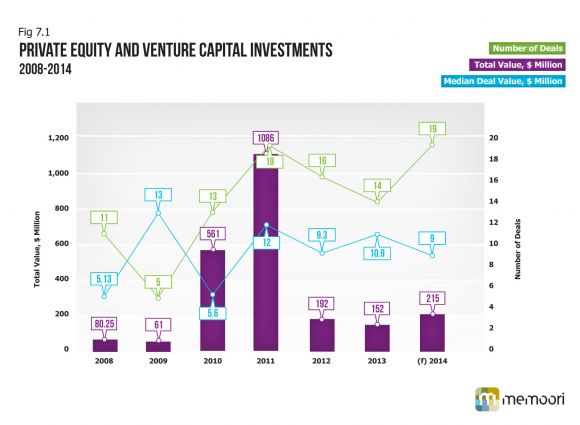Although significant consolidation has already occurred across the LED value chain, further consolidation will be required for the market to mature to a stable state.
Some of the drivers of this process will be achieving economies of scale, cost reductions, sustainable market share and access to innovative IP to meet rising output requirements. This will further increase the likelihood of deal activity to 2018. Memoori recently released a research report on investment activity in the LED sector, finding that deal activity has not met expectations set a couple of years ago.
Both overall VC Investment flows and cleantech-specific VC funding were on a downward trend in 2012 and 2013; however, of all the cleantech sectors, energy efficiency companies continued to attract the most VC investment throughout 2013.
According to data from the Cleantech Group, the sector soaked up 19 percent of all venture investments during the first six months of 2013. The number of energy efficiency deals rose 45 percent in the second quarter for a total of 79 through June.

Private equity players still believe that there is money to be made in LED lighting. However, an analysis of 2012 and 2013 data indicates a small decline in the number of deals closed compared to the 2011 peak of nineteen deals. There was also a 29 percent decline in median deal value to $9.3 million, indicating that investors are proceeding with an element of caution. From an analysis of deals to date this year, our forecasts show this cautious trend continuing at around the same pace through 2014.
Much of the hype surrounding the LED market has now dissipated. Entrepreneurs and VCs who invested over the last two to three years expecting fast returns and big exits are likely to be disappointed. Growth has failed to meet the expectations, which were buoyed by optimistic projections touted by the market only eighteen months ago.
Smart control systems are becoming increasingly important due to LED commoditization, making them a potentially hot sector for investment. This should encourage broader adoption of smart technology in both the commercial and residential sectors.
Memoori believes that venture and startup activity will be much more pronounced in the later stages of the supply chain. Innovations in control systems and services tend to be software-intensive, capital-efficient and well aligned with the traditional venture capital investment approach of using small amounts of capital to yield potentially large returns.
In the next several years, it will still be necessary to make further strategic investment in R&D to develop attractive new LED lighting products and systems. Large corporations and industrials will have strategic motivations to foster this continued R&D investment to help them differentiate from the competition. As such, we may yet see as much investment coming from these sources as from VC funding.
***
Jim McHale founded Memoori in 2008. It is a consultancy based in London that provides market research, business intelligence and financial deal tracking services to clients across several industries. More details on Memoori’s LED investment report can be found here.



